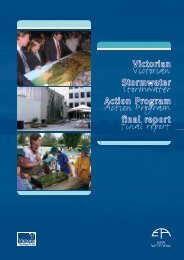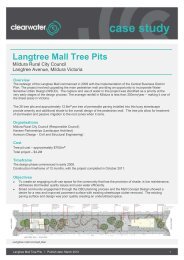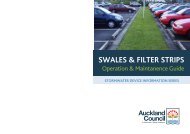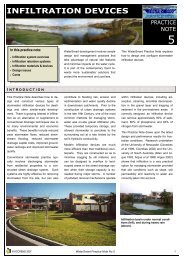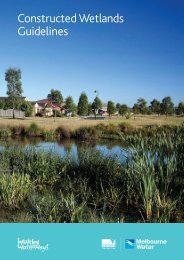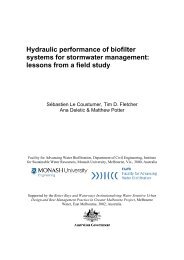CRC Street Sweep Eval 1999.pdf( 489.9 KB ) - Clearwater
CRC Street Sweep Eval 1999.pdf( 489.9 KB ) - Clearwater
CRC Street Sweep Eval 1999.pdf( 489.9 KB ) - Clearwater
Create successful ePaper yourself
Turn your PDF publications into a flip-book with our unique Google optimized e-Paper software.
COOPERATIVE RESEARCH CENTRE FOR CATCHMENT HYDROLOGY<br />
The Coburg gross pollutant wet load data have<br />
incorporated the effect of Moreland City Council’s<br />
street sweeping practices which range from daily to<br />
fortnightly, depending on land-use. How exactly any<br />
alterations made to the street sweeping frequency<br />
would affect the gross pollutant load in stormwater<br />
(see Figure 8.2) is not known and cannot be<br />
ascertained from the data collected. However, it is<br />
possible for some inference of the effectiveness of<br />
street sweeping in limiting the export of gross<br />
pollutants from street surfaces to the stormwater<br />
system to be made, and this will be discussed in<br />
Section 9.2.<br />
Despite rainfall wash-off being the dominant factor<br />
transporting gross pollutants from street surfaces,<br />
litter can also reach the stormwater system during dry<br />
weather periods. The litter monitoring study,<br />
conducted by Hall and Phillips (1997), in the<br />
Carnegie commercial catchment indicated that during<br />
dry days numerous gross pollutant items are<br />
transported into the stormwater system by factors<br />
other than stormwater runoff (eg. wind or direct<br />
dumping). That study focused on measuring the<br />
number of litter items as well as material composition<br />
collected daily over seven days, from identified<br />
catchment pollutant sources. SEPTs were placed in<br />
drain entry pits located in the study area to determine<br />
the number of litter items reaching the stormwater<br />
system from the identified catchment pollutant<br />
sources (including bins, footpaths and street surfaces).<br />
The results showed that up to 78 items of litter in total<br />
(per day) were collected in SEPTs during periods<br />
without rainfall. A substantial amount of the material<br />
trapped during recorded dry days were lighter items<br />
(polystyrene) although numerous heavier items were<br />
also found, indicating possible direct littering rather<br />
than wind blown transportation of street surface<br />
pollutants.<br />
Gross Pollutant Load Generation:<br />
Data collected in the Coburg catchment indicated washoff of gross pollutants becomes significant for<br />
storm events greater than 3.7 mm of rainfall depth or 0.70 mm of runoff.<br />
The limiting mechanism affecting the transport of gross pollutants in the majority of cases appears to be<br />
re-mobilisation and transport processes (ie. stormwater runoff rates and velocities) and not the supply of<br />
gross pollutants.<br />
Approximately 35% of all recorded rainfall events in Melbourne are greater than 3.7 mm giving an<br />
average inter-event dry period of 178 hours (7.4 days) for gross pollutant transporting storm events.<br />
27




